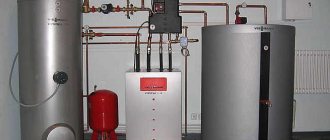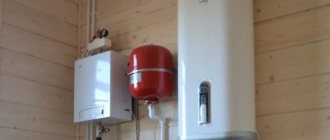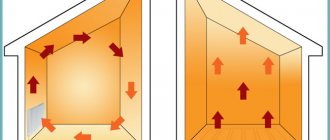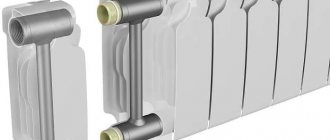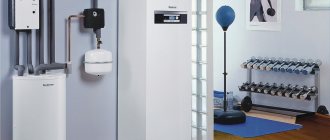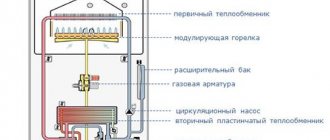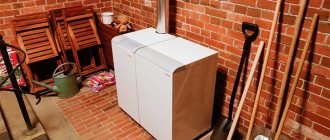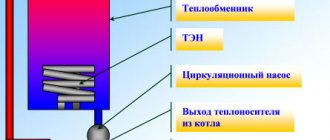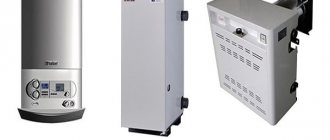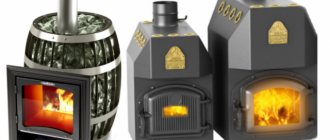We are faced with a dilemma: wall-mounted or floor-mounted gas boiler - which is better? Believe me, every second buyer of heating equipment turns to consultants with this question. And it’s good if he comes across a competent and qualified specialist. It’s another matter if the person in front of him is an amateur...
Since you do not know which consultants or sellers you will have to deal with, we recommend that you sort out everything in this matter for yourself before going to the store.
We offer a professional answer to the question of which boiler is better for a home or apartment, as well as what exactly. In this comparative review, you will learn how they differ from each other and what these differences affect in the process.
Dimensions and weight
Dimensions are one of the most important differences between wall-mounted and floor-standing gas boilers. The dimensions and weight of wall-mounted models are much more modest, otherwise it would simply be impossible to mount them on the wall without the risk of collapse. The lightness of the design is achieved not only by the overall compactness of wall-mounted models, but also by the material from which the heat exchanger is made.
For wall-mounted models, the heat exchanger is made only of steel; floor-standing models may have heat exchangers made of cast iron, which is significantly heavier, or steel.
Wall-mounted boilers are often called mini-boiler rooms. And this is no coincidence, because a relatively small-sized housing houses not only the burner, heat exchanger and control system components, but a circulation pump, expansion tank and other elements without which the operation of a conventional boiler room is indispensable. The compactness of the wall-mounted boiler is its main and undeniable advantage. There is no need to allocate a separate room for such a device, because it can be placed anywhere, for example, in the kitchen.
Wall-mounted gas boiler with a coaxial chimney, located in the kitchen.
Floor-standing models inspire confidence with their size. This is exactly what a powerful boiler should be, providing the ability to heat a large building. However, the dimensions of floor-standing boilers often turn into a problem for their owners. Sometimes, in order to bring such a “giant” into a room, you have to dismantle the doorways. There were cases when, due to the impossibility of bringing equipment into the boiler room, the purchased floor-standing gas boiler had to be replaced with two smaller ones.
Floor-standing gas boiler and indirect heating boiler.
Operating principle
The operating principle of both types of boilers is the same. The main design elements are a gas burner and a heat exchanger, combined into a single unit.
The coolant enters the heat exchanger, receives a high temperature there and is discharged to the secondary unit. In it, thermal energy is partially spent on preparing hot water. After this, the liquid passes into a three-way valve, mixes in a given proportion with the colder return flow and receives a temperature determined by the current operating mode.
After this, the coolant leaves the boiler and enters the heating circuit, where it makes a circle and returns to the boiler as a return flow. The air is supplied by a turbofan, which also ensures smoke exhaust.
Circulation occurs under the action of a circulation pump. The operation is constantly monitored by a control board and a system of sensors that can detect any problems and immediately notify the owner about them.
Equipment
The factory configuration of a wall-mounted gas boiler, as a rule, includes not only the heating device itself, but also a circulation pump, an expansion tank, control system elements, and all the necessary sensors and valves. Moreover, all this is hidden in the body of the boiler itself.
By purchasing a wall-mounted gas boiler, you get a miniature boiler room for your use, that is, the minimum set that, after connecting to the heating system, is able to begin full-fledged work on heating your home.
Of course, if you wish, you can additionally purchase all kinds of room thermostats and regulators, outside temperature sensors, a GSM communication module and much more, improving the heating system of your home and increasing the comfort of its control.
A floor standing boiler is usually just a boiler. Circulation pumps, an expansion tank and many other related equipment are not included in the delivery package - you will have to purchase everything you need separately.
Wall-mounted gas boiler with lid removed.
Comparison using two models as an example
Let's compare similar models of different types of installation from one of the most common manufacturers BAXI:
| Characteristics | BAXI LUNA-3 COMFORT 1.240 Fi (wall convection) | BAXI SLIM 1.230 iN (floor convection) |
| Number of circuits | single-circuit | single-circuit |
| power, kWt | 25 | 22,1 |
| Efficiency, % | 92,9 | 90,2 |
| Combustion chamber type | closed | open |
| Heat exchanger material | copper | cast iron |
| Natural gas consumption, m3/hour | 2.84 (0.1136 m3 per 1 kW) | 2.59 (0.1172 m3 per 1 kW) |
| Dimensions (WxHxD), mm | 450x763x345 | 350x850x600 |
| Weight, kg | 36 | 103 |
| Equipment and functions | circulation pump, expansion tank (8 l), power indicator, thermometer, pressure gauge, auto-ignition, flame modulation, room thermostat, programmer, remote control, external control connection, heated floor connection | power indicator, auto-ignition, flame modulation, external control connection, underfloor heating connection |
| Protection and safety | autodiagnostics, gas control, overheating protection, frost prevention mode, safety valve, air vent, pump blocking protection | autodiagnostics, gas control, overheating protection, frost prevention mode, pump blocking protection |
| Cost, rub. | 49 000 | 61 000 |
The difference between the models is noticeable; moreover, one of the best, most efficient and functional models was taken as a representative of floor-standing gas boilers. Comparing other models, you can notice a much more noticeable difference in gas consumption, the lack of protection against pump blocking and the anti-freezing mode in the floorstands.
Easy to install
Which boiler, wall-mounted or floor-mounted, is easier to install? It would seem that this question should concern not potential owners of the unit, but exclusively the craftsmen who will be involved in deploying the heating system. However, do not forget that the buyer, that is, you, will have to pay for this, and the more labor-intensive the work, the more money you will have to part with.
In terms of ease of installation, the wall-mounted boiler is the undisputed leader. In the case of a floor-standing unit, you will have to equip an entire boiler room, because in addition to the boiler itself, you will have to install circulation pumps, an expansion tank and, perhaps, a boiler. The scope of work, as you might guess, differs very significantly, and the cost of the work will vary just as much.
Life time
When purchasing any equipment, especially expensive equipment, we want it to serve, if not always, then at least for as long as possible. This fully applies to gas boilers. Which boiler, wall-mounted or floor-mounted, will properly heat our home for many years?
The service life of a gas boiler is primarily determined by the service life of its heat exchanger. There is currently no consensus on which heat exchanger material is better - each has its own advantages and disadvantages.
In floor-standing models, cast iron heat exchangers are usually installed. Cast iron is less susceptible to corrosion, but at the same time it is fragile, which means there is a risk of microcracks forming during transportation. In addition, it does not tolerate sudden changes in temperature. When hard water is used as a coolant, the cast iron heat exchanger slowly deteriorates as a result of scale formation and, as a consequence, local overheating of the material.
Cast iron heat exchanger.
Cast iron heat exchangers are not suitable for wall-mounted gas boilers, because they are too heavy. The most preferred material in this case is steel. The latter is not afraid of shocks during transportation, but is highly corroded during operation, especially incorrectly.
Steel heat exchanger for a gas boiler.
So which heat exchanger is better? Since the boiler does not have to be transported very often, the factor that has the greatest impact on the service life of this structural element can be considered corrosion resistance. From this we can conclude that a longer period of normal operation can be expected from a floor-standing boiler with a cast iron heat exchanger.
We should not forget that the service life of the boiler is also affected by the wear of other structural elements - circulation pumps, gas valve, electronics, etc. The quality of the unit depends on the quality of each of its individual components. Practice shows that the average boiler from a well-known manufacturer who cares about the reputation of the brand will serve you well for 15-20 years, no matter whether it is wall-mounted or floor-mounted. No one knows what to expect from a “no name” unit.
Of course, in order for heating equipment to work long enough, you should follow all the manufacturer’s recommendations regarding operating conditions and carry out the necessary maintenance in a timely manner. The user can cope with many problems that arise on his own thanks to the self-diagnosis tools available in modern equipment.
Conclusions and useful video on the topic
The expert from the video below will talk in detail about what myths exist regarding both types of equipment and what their features are during operation. This information should finally help you make your choice.
Each type of equipment has its own advantages and disadvantages, so it is impossible to single out a clear leader in this comparative review. It all depends on the conditions and at what facility the boiler will be operated.
Share what you were looking for when buying a gas boiler to furnish your own country house or city apartment. It is possible that your recommendations will be useful to site visitors. Please leave comments in the block below, post photos and ask questions.
Coolant quality
The service life of a gas boiler and its output directly depend on the quality of the coolant. Using water with increased hardness as a coolant leads to the formation of scale inside the heat exchanger. Scale, in turn, causes a significant decrease in boiler efficiency and, as a consequence, an increase in fuel consumption.
The heat exchanger of the gas boiler is clogged with lime.
Both floor-standing and wall-mounted boilers “suffer” from scale to approximately the same extent; only the level of difficulty in solving an existing problem differs. The ease of disassembling and washing the steel heat exchanger of a wall-mounted boiler allows you to quickly restore the functionality of heating equipment right at the installation site.
Washing the cast-iron heat exchanger of a floor-standing boiler is difficult and, moreover, not always possible (many manufacturers insist that its disassembly and assembly be carried out exclusively in the factory). Most often, a faulty or clogged cast iron heat exchanger simply has to be replaced, and this part is by no means cheap.
It follows from this that installing a floor-standing boiler with a cast iron heat exchanger requires that you have a chemical water treatment plant. This device is not cheap, but in this case it is extremely necessary.
Optimal choice of boiler
When choosing gas boilers for heating a private home, you need to take into account some criteria and parameters:
- Performance. The choice of power for wall-mounted gas products is limited to models up to 95-100 kW. At the same time, some manufacturers release only 40 kW devices onto the market.
- Financial savings - the key difference between a floor-standing unit and a wall-mounted unit is its more affordable cost. However, mounted models are good because they support turbocharged or condensing operating modes and are characterized by reduced fuel consumption.
- Operational life - with proper maintenance and compliance with operating rules, a mounted boiler can last no more than 15 years. For comparison, the service life of floor structures exceeds 20 years.
- Energy dependence. If your region experiences frequent power outages, power surges or power outages, it is not advisable to use wall-mounted boilers.
When replacing a floor-standing boiler with a wall-mounted one, you need to prepare regulatory documentation and coordinate some points with the relevant services. This is stated in the regulations. If you do not make changes to the project, during a scheduled inspection, a Rostechnadzor inspector may turn off the gas supply without new documentation.
Stationary and mounted boiler units have pros and cons. However, despite a lot of weaknesses, representatives of the wall group are rapidly gaining popularity and replacing traditional floor products.
Power modulation
Depending on the implemented method of regulating the flame intensity, all boilers are divided into boilers with a stepped or modulating burner. One- and two-stage burners have one or two operating modes, respectively (usually 100% and 70% of maximum). The power of modulating burners can be smoothly adjusted over a fairly wide range, which allows fine-tuning the operation of the boiler. Modulating burners provide fuel savings and allow you to maintain the set temperature with minimal deviations.
A significant part of floor-standing gas boilers are equipped with one- or two-stage burners. Most wall-mounted models have a wide range of power modulation (from 40 to 100%), due to which they operate “softer” - they turn on and off much less frequently than boilers with stepped burners.
Energy independence
For some consumers, an important parameter of a gas boiler may be the dependence of its operation on electricity. The energy independence of heating equipment is relevant for those whose house or cottage is located at a considerable distance from large populated areas, i.e. in places where power outages or power surges in the network are possible, leading to the failure of expensive automation.
Autonomy of a gas boiler can be achieved in two ways. The first is to simplify the boiler control system as much as possible. That is, it is necessary to use a unit in which there is no electronics at all. All automation of such a boiler is mechanical. A heating system that uses a similar boiler that operates without electricity must have natural circulation.
The second method is to use an electric generator, which converts the heat obtained by burning gas into electricity necessary for the operation of the boiler automation. This option is preferable for most users because it creates fewer restrictions.
You can find energy-independent models only among floor-standing gas boilers, which for some buyers will be a strong argument in favor of the latter.
Installation site requirements
Before choosing a floor-standing or wall-mounted gas boiler, you should resolve the issue regarding its installation location.
Due to its compactness, the wall-mounted boiler can be placed in almost any room. The main thing is that a number of requirements are met to guarantee the safety of its operation: a closed combustion chamber, connection to a coaxial chimney, forced removal of flue gases and injection of air to maintain the combustion process. Installing a boiler with an open combustion chamber in a kitchen where there is a hood is unacceptable, since in this case a so-called “draft reversal” is possible, in which the smoke from the boiler will not go into the chimney, but into the room.
There are not many options for placing a floor-standing gas boiler. Due to the size of the boiler itself, as well as all kinds of related equipment, we can only talk about a separate room - the boiler room. Despite the fact that the boiler room does not belong to residential premises, when installing a gas boiler, it is necessary to ensure normal removal of fuel combustion products and air flow.
Pros and cons in comparison
Before buying a boiler, carefully study the strengths and weaknesses of both types of equipment. They differ not only in appearance, weight and gas consumption, but also in performance characteristics. The table below will help you learn more about these differences.
The following table presents the advantages and disadvantages of a floor-standing boiler:
| pros | Minuses |
| 1. High productivity due to the large volume of the combustion chamber. | 1. Heavy weight. Especially when it comes to industrial models, although household ones are also not compact. |
| 2. Reliable heat exchangers made of thick-walled steel or cast iron, which guarantee a long service life. | 2. Classic type of chimney. This means that you will have to punch a hole into the street and connect a pipe to it that is far from aesthetically pleasing. |
| 3. Non-volatile. They can even heat objects without electricity. | 3. Impressive dimensions that can take up most of the living space in the room. |
The following table will familiarize you with the strengths and weaknesses of wall-mounted boilers:
| pros | Minuses |
| 1. Cost-effective. Allows you to save up to 10-15% gas compared to the floor-standing version. | 1. Energy dependence. It contains pumps, sensors and automation that operate from the network. |
| 2. Closed combustion chamber. This results in two advantages: compactness, lightness and the ability to be installed almost anywhere. | 2. Sensitivity to voltage changes. Often, at the slightest jump, the controller burns out, and such a breakdown requires expensive repairs. |
| 3. Multifunctionality. The latest models are equipped with weather-compensating automation, Internet access and can be controlled by a remote control or smartphone. | 3. Installation and configuration of such equipment is a complex and lengthy process. In addition, there really aren’t many competent specialists who can do it correctly. |
We propose to consider the differences between these modifications of gas equipment on real models, which are currently in high demand and are available from most suppliers.
| Proterm Bear 20 KLOM (floor-standing) | Proterm Lynx Condens 25/30 MKV (wall-mounted) | |
| Ignition | Electrical | Electronic |
| Thermal power (natural gas / liquefied gas) (kW) | 11,9-17/11,2-16 | 6,3-26,5 |
| Efficiency (not less) (%) | 90-92/89-91 | 104 |
| Heat exchanger material | Cast iron | Aluminum-silicon alloy |
| Rated voltage/frequency (V/Hz) | 230/50 | 230/50 |
| Dimensions: width / length / height (mm) | 335/600/880 | 700 / 390 / 280 |
| Weight without water (kg) | 90 kg | 32 |
| DHW | No | There is |
Take the choice of equipment type seriously, since in the future replacing, for example, a floor-standing boiler with a wall-mounted one and vice versa will not be cheap. You will have to pay for the production of new project documentation and registration.
Finally, I would like to note the following market trend: wall-mounted boilers are gradually replacing models that are installed on the floor.
This must also be taken into account, since the further you go, the more difficult it may be to find parts for floor-standing boilers, as well as to find craftsmen who can provide qualified assistance in the event of a breakdown.
Power
The power of wall-mounted gas boilers, as a rule, varies from 10 to 40 kW. This, according to a rough estimate, is enough to heat a home with an area of 100 to 400 square meters. m. However, if part of the heat is used to heat water for domestic needs, then this power will be enough to heat only a relatively small house.
The capabilities of floor-standing gas boilers are significantly higher. The power of floor-standing models can reach 80-100 kW, and if it is equipped with a forced-air burner rather than an atmospheric one, then even more. If you need to heat a huge house or industrial facility, then a floor-standing boiler is exactly what you need.
Which boiler is best for a home or apartment?
It is difficult to give a universal assessment, since each situation is individual, but basically in practice it happens like this:
- floor structures are purchased for heating the private sector (houses, cottages);
- hanging - for apartments due to their small size and visual appeal.
Although it is important to make a reservation here. In every sense, floor-mounted mini-boiler rooms are definitely more reliable, since they have a more durable heat exchanger, and they are also easy to use even at critically low temperatures outside.
Plus, add energy independence to everything, and then you will understand why many people prefer to install them even in apartments.
Wall-mounted boilers are good because they can be built into kitchen units and take up a minimum of usable space in small urban kitchens
But if you have limited living space and live in a region where severe frosts are very rare, it is more rational to install a wall modification. It will also cost less.
Final comparison of wall-mounted and floor-standing gas boilers
| Wall-mounted gas boiler | Floor standing gas boiler | |||||||
| Dimensions | Less | More | ||||||
| Weight | Less | More | ||||||
| Equipment | The boiler is equipped with additional equipment | Additional equipment must be purchased separately | ||||||
| Easy to install | Easier | More difficult | ||||||
| Life time | Steel heat exchangers are more susceptible to corrosion, which reduces service life | Units with a cast iron heat exchanger can operate for a longer time | ||||||
| Coolant quality | The dependence on the quality of the coolant is high, but it is easier to flush the heat exchanger | The dependence on the quality of the coolant is average, but it is more difficult to flush the heat exchanger | ||||||
| Power modulation | More possibilities | Fewer features | ||||||
| Energy independence | Fully volatile units | There are non-volatile units | ||||||
| Installation site requirements | Less | More | ||||||
| power, kWt | 10 — 40 | 80 — 100 | ||||||
| Price | Below | Higher | ||||||
If you notice an error, a non-working video or link, please select a piece of text and press Ctrl+Enter .
0
